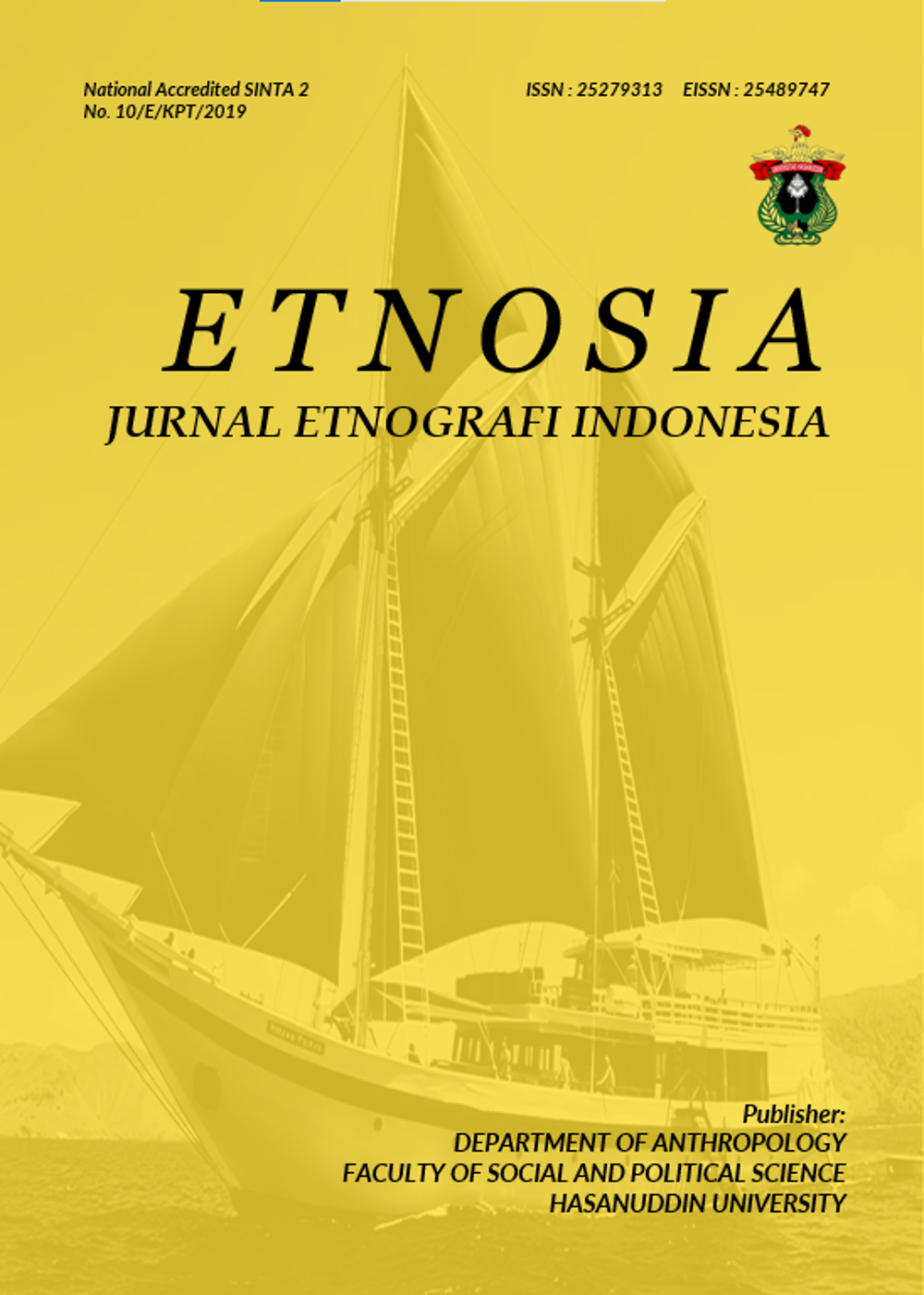Abstract
This paper discusses a unique side of the Bugis that has not received attention in several literatures about the Bugis. The Buginese tends to express himself excessively and aggressively. Local people label such self-expression as pojiale, instead of using siri na pesse (one of the Bugis ethics and cultural values) as the primary reference to describe the character and behavior of the Bugis people, but rather based on the experience and reflection of the author as a Bugis person who was born and grew up in the life of the Buginese. From this experience and reflection, the author finds the pojiale as the unique character possessed by the Bugis. The gap between the ideal values of Bugis culture (Bugis ethics and siri na pesse culture) are factually practiced in the social life of the Bugis.
References
Ananta, A., Arifin, E. N., & Bakhtiar. (2005). Ethnicity and ageing in Indonesia, 2000–2050. Asian Population Studies, 1(2), 227-243.
Pelras, C., Abu, A. R., & Arsuka, N. A. (2006). Manusia Bugis. Nalar: Forum Jakarta-Paris: École Française d'Extrême-Orient (EFEO).
Bakti, A. F. (2010). Diaspora Bugis di Alam Melayu Nusantara. Makassar: Ininnawa.
Bateson, G., & Mead, M. (1942). Balinese character: A photographic analysis. New York, 17-92.
Benedict, R. (1974). Ruth Benedict. Columbia University Press.
Danandjaja, J. (1988). Antropologi psikologi: teori, metode dan sejarah perkembangannya.
Goodenough, W.H. (1994). “Toward a Working Theory of Culture” in Robert Borofsky (ed.) Assessing Cultural Anthropology. New York: McGraw-Hill Inc, pp. 262-275.
Huzain, M., Rajab, H., & Wekke, I. S. (2016). Sipakatau: Konsepsi Etika Masyarakat Bugis. Deepublish.
Kapojos, S. M., & Wijaya, H. (2018). Mengenal Budaya Suku Bugis. Jurnal Lembaga STAKN Kupang| MATHETEUO Vol, 6(2), 153.
Keesing, R. M. (1992). Cultural Anthropology: A Contemporary Perspective; Antropologi Budaya: Suatu Perspektif Kontemporer, Terj. RG Soekadijo, Edisi kedua, Jakarta: Erlangga.
Kodiran. (2004). Pewarisan Budaya dan Kepribadian (Cultural Inheritance and Personality). Jurnal Humaniora, Volume 16 No. 1.
Kottak, C. P. (2015). Cultural anthropology: Appreciating cultural diversity. McGraw-Hill Education.
Mattulada, H.A. (1974). Bugis-Makassar: Manusia dan Kebudayaannya. Berita Antropologi, Jakarta (edisi khusus).
Mattulada, H. A. (1995). Latoa suatu Lukisan Analis terhadap Antropologi Politik Orang Bugis, penerbit Gadjah Mada University Press.
Millar, S. B. (2010). Perkahwinan Bugis, Refleksi Status Sosial Dan Budaya Di Baliknya. Penerbit Ininnawa.
Moein MG, A. (1977). Menggali Nilai Sejarah Kebudayaan Sulselra Siri’ & Pacce. Ujung Pandang: SKU Makassar Press.
Noorduyn, J., & Salim, M. (1988). Special Buginese characters in Luwu'manuscripts. Bijdragen tot de Taal-, Land-en Volkenkunde, 144(2/3), 351.
Ortner, S. B. (1984). Theory in Anthropology since the Sixties. Comparative studies in society and history, 26(1), 126-166.
Christian, P. (2005). Manusia Bugis. Jakarta: Nalar.
Rahim, A. R. (1985). Nilai-Nilai Utama Kebudayaan Bugis. Ujung Pandang: Lembaga Penerbitan Universitas Hasanudin.
Reed-Danahay, D. E. (2021). Leaving home: Schooling stories and the ethnography of autoethnography in rural France. In auto/ethnography (pp. 123-143). Routledge.
Rusli, M. (2019). Impelementasi nilai Siri’Napacce dan agama di tanah rantau; Potret Suku Bugis-Makassar Di Kota Gorontalo. AL ASAS, 3(2), 73-86.
Said, M. (2016). Jati Diri Manusia Bugis. Jakarta: Pro De Leader.
Abidin, A. Z. (1999). Capita Selecta Kebudayaan Sulawesi Selatan.
Zainal, Z., & Wahyuni, S. (2018). Siri'Na Pesse dalam Masyarakat Bugis di Kota Tanjungpinang. Jurnal Masyarakat Maritim, 2(1), 34-44.
Saudagar Bugis-Makassar – “Pertemuan Saudagar Bugis-Makassar: Janganlah Melupakan Budaya“ (Bugis-Makassar Merchants – “Bugis-Makassar Merchant Meeting: Don't Forget Culture), Kompas, Diakses 15 Desember 2021.
Weber, M. (2015). Etika Protestan dan Semangat Kapitalisme. Yogyakarta: Narasi.
Wijono, S. (2010). Psikologi industri & organisasi. Kencana.

This work is licensed under a Creative Commons Attribution-NonCommercial 4.0 International License.
Copyright (c) 2021 ETNOSIA : Jurnal Etnografi Indonesia





